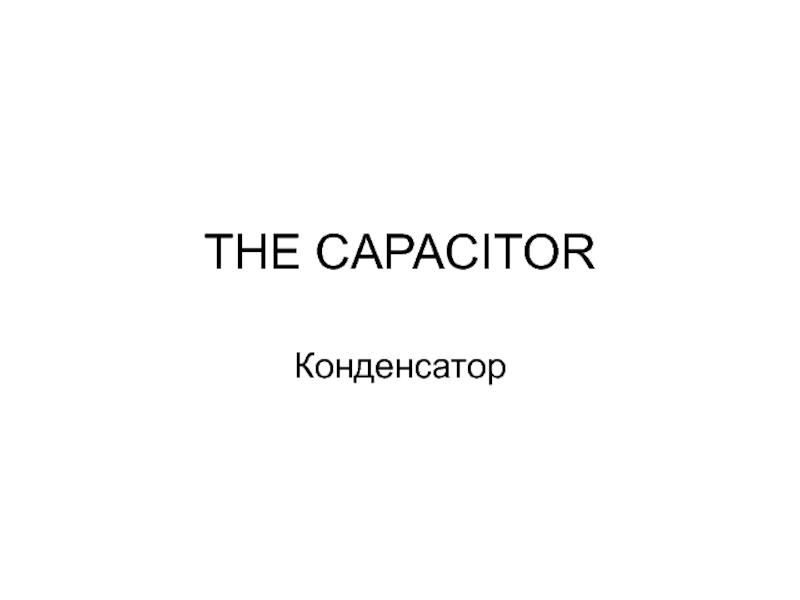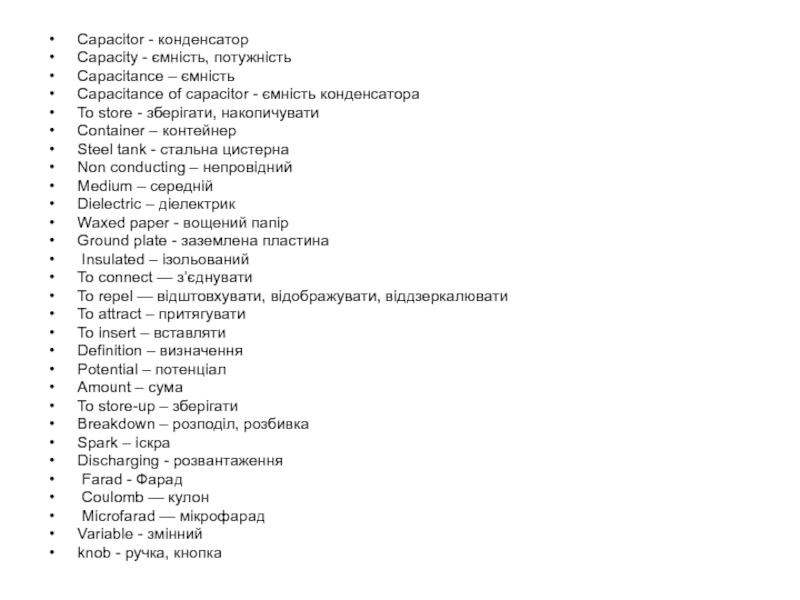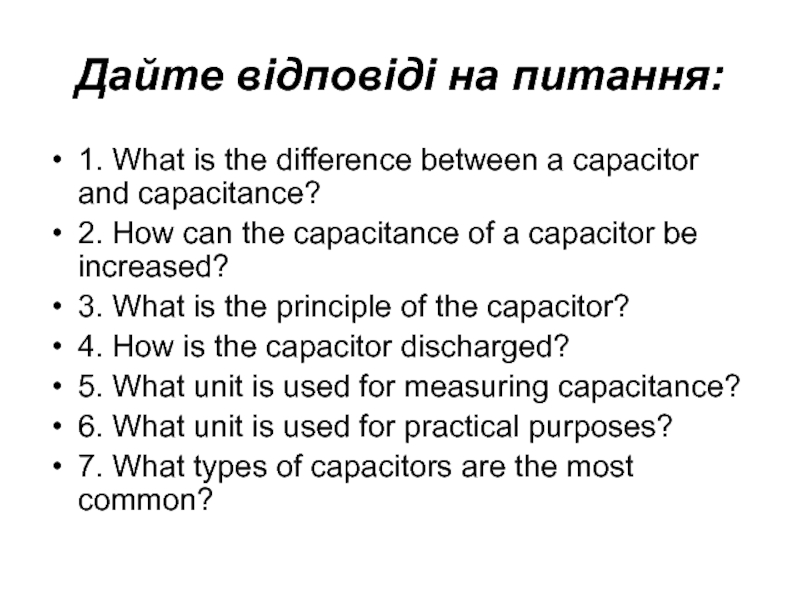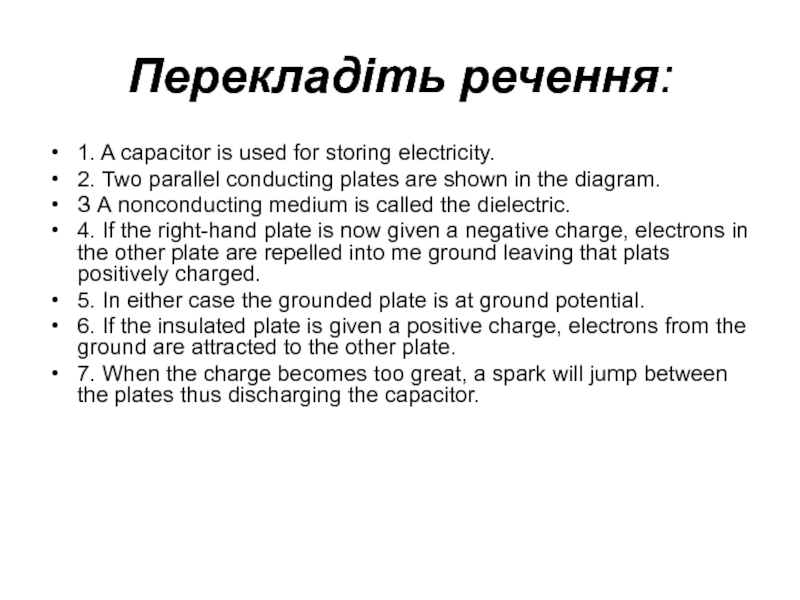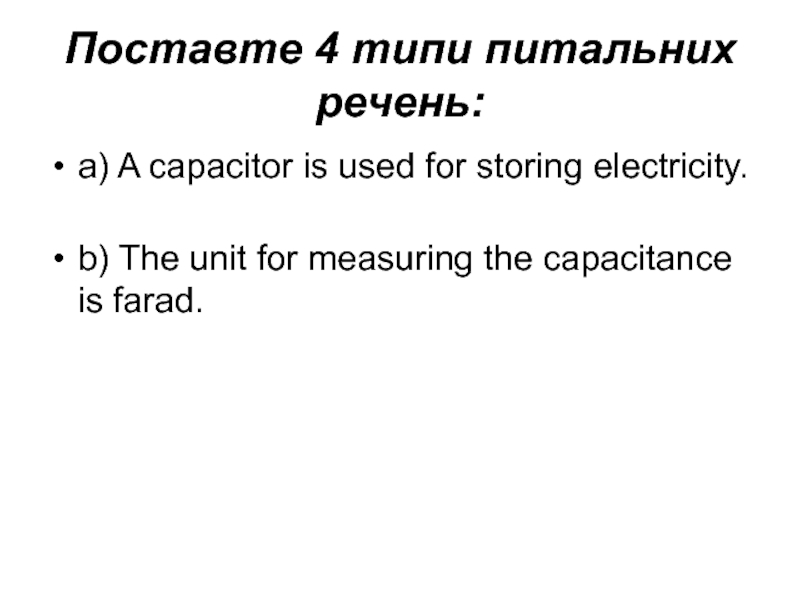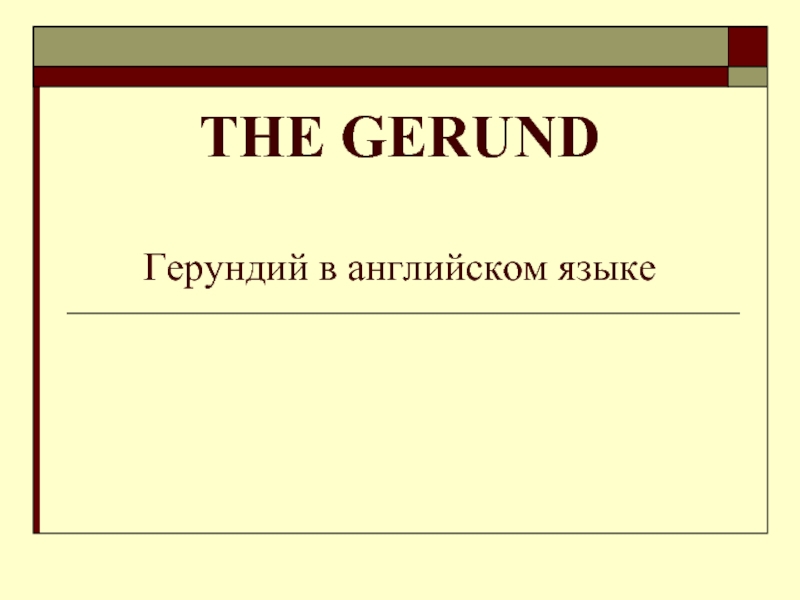- Главная
- Разное
- Дизайн
- Бизнес и предпринимательство
- Аналитика
- Образование
- Развлечения
- Красота и здоровье
- Финансы
- Государство
- Путешествия
- Спорт
- Недвижимость
- Армия
- Графика
- Культурология
- Еда и кулинария
- Лингвистика
- Английский язык
- Астрономия
- Алгебра
- Биология
- География
- Детские презентации
- Информатика
- История
- Литература
- Маркетинг
- Математика
- Медицина
- Менеджмент
- Музыка
- МХК
- Немецкий язык
- ОБЖ
- Обществознание
- Окружающий мир
- Педагогика
- Русский язык
- Технология
- Физика
- Философия
- Химия
- Шаблоны, картинки для презентаций
- Экология
- Экономика
- Юриспруденция
The capacitor презентация
Содержание
- 1. The capacitor
- 2. Capacitor - конденсатор Capacity - ємність,
- 3. Прочитати та перекласти текст: A capacitor is
- 4. The principles of the capacitor are
- 5. The unit of capacitance, the farad,
- 6. Дайте відповіді на питання: 1. What
- 7. Перекладіть речення: 1. A capacitor is
- 8. Поставте 4 типи питальних речень: a)
Слайд 2Capacitor - конденсатор
Capacity - ємність, потужність
Capacitance – ємність
Capacitance of capacitor
- ємність конденсатора
To store - зберігати, накопичувати
Container – контейнер
Steel tank - стальна цистерна
Non conducting – непровідний
Medium – середній
Dielectric – діелектрик
Waxed paper - вощений папір
Ground plate - заземлена пластина
Insulated – ізольований
To connect — з’єднувати
To repel — відштовхувати, відображувати, віддзеркалювати
To attract – притягувати
To insert – вставляти
Definition – визначення
Potential – потенціал
Amount – сума
To store-up – зберігати
Breakdown – розподіл, розбивка
Spark – іскра
Discharging - розвантаження
Farad - Фарад
Coulomb — кулон
Microfarad — мікрофарад
Variable - змінний
knob - ручка, кнопка
To store - зберігати, накопичувати
Container – контейнер
Steel tank - стальна цистерна
Non conducting – непровідний
Medium – середній
Dielectric – діелектрик
Waxed paper - вощений папір
Ground plate - заземлена пластина
Insulated – ізольований
To connect — з’єднувати
To repel — відштовхувати, відображувати, віддзеркалювати
To attract – притягувати
To insert – вставляти
Definition – визначення
Potential – потенціал
Amount – сума
To store-up – зберігати
Breakdown – розподіл, розбивка
Spark – іскра
Discharging - розвантаження
Farad - Фарад
Coulomb — кулон
Microfarad — мікрофарад
Variable - змінний
knob - ручка, кнопка
Слайд 3Прочитати та перекласти текст:
A capacitor is an electrical device for storing
quantities of electricity in much the same way that a reservoir is a container for storing water or a steel tank is a container for storing gas. The general form of a capacitor is that of two parallel conducting plates as shown in Fig. 1.
Such plates are of relatively large area, close together, and contain between them a nonconducting medium called the dielectric. Common dielectrics are air, glass, oil and waxed paper.
Quantitatively, the capacitance of a capacitor is measure of its ability to store-up electricity. To increase the capacitor of a capacitor, one of the following changes can be made: firs, the area of the plates may be increased; second, the plates may be put closer together; and third, a more suitable dielectric may be inserted between the plates. If the plates of a capacitor are small in area and at the same time relatively far apart, the capacitance is small. If the area is large and the plates close together, the capacitance is large.
Such plates are of relatively large area, close together, and contain between them a nonconducting medium called the dielectric. Common dielectrics are air, glass, oil and waxed paper.
Quantitatively, the capacitance of a capacitor is measure of its ability to store-up electricity. To increase the capacitor of a capacitor, one of the following changes can be made: firs, the area of the plates may be increased; second, the plates may be put closer together; and third, a more suitable dielectric may be inserted between the plates. If the plates of a capacitor are small in area and at the same time relatively far apart, the capacitance is small. If the area is large and the plates close together, the capacitance is large.
Слайд 4
The principles of the capacitor are illustrated in Fig. 1. One
plate of this capacitor grounded, and the other is insulated but connected to an electroscope or electrometer. If the right-hand plate is now given a negative charge as shown, electrons in the other plate are repelled into the ground, leaving that plate positively charged. If the insulated plate is given a positive charge (not shown), electrons from the ground are attracted to the other plate and it's acquired a negative charge.
In either case the grounded plate is, by definition, at ground potential or zero potential. The right-hand plate is at negative potential, since, if connected to the ground, its electrons would escape into the ground. As shown in the diagram, the capacitor is charged. If the 1 two plates of a capacitor are suddenly connected by a conductor the negative charges can flow through the conductor to the positive charges, thus neutralizing the charges. The capacitor has thus been discharge
During the time a capacitor is being charged, the plates acquire a greater and greater deference of potential. If in Fig. 12 more electrons are added to the insulated plate, the potential difference is increased. The amount of charge stored-up in this way is limited only by the breakdown of the dielectric between the two plates. When the charge becomes too great, a spark will jump between the plates, thus discharging the capacitor.
In either case the grounded plate is, by definition, at ground potential or zero potential. The right-hand plate is at negative potential, since, if connected to the ground, its electrons would escape into the ground. As shown in the diagram, the capacitor is charged. If the 1 two plates of a capacitor are suddenly connected by a conductor the negative charges can flow through the conductor to the positive charges, thus neutralizing the charges. The capacitor has thus been discharge
During the time a capacitor is being charged, the plates acquire a greater and greater deference of potential. If in Fig. 12 more electrons are added to the insulated plate, the potential difference is increased. The amount of charge stored-up in this way is limited only by the breakdown of the dielectric between the two plates. When the charge becomes too great, a spark will jump between the plates, thus discharging the capacitor.
Слайд 5
The unit of capacitance, the farad, named in honour of Michael
Faraday, is defined as the capacitance of a capacitor of such dimensions that a charge of one coulomb will give the plates a difference of potential of one volt:
A capacitance of 1 farad is very large and for practical purposes is not used The microfarad is more convenient. The smaller unit is one millionth of the farad and is abbreviated µf. In other words, 1,000,000 microfarads are equivalent to 1 farad. A still smaller unit, the microfarad, is sometimes used. One microfarad is one-millionth; of 1 microfarad and is abbreviated µµf. Capacitors in common use today are of various kinds, sizes and shapes. Perhaps the most common is the so-called "paper capacitor" used commonly in radios and the ignition system of automobiles. Another type of capacitor is the variable capacitor commonly used in tuning radios. The capacitance of such a device can be varied by the turning of a knob. The capacitance of such variable air capacitors is from zero to about 4000 µµf.
A capacitance of 1 farad is very large and for practical purposes is not used The microfarad is more convenient. The smaller unit is one millionth of the farad and is abbreviated µf. In other words, 1,000,000 microfarads are equivalent to 1 farad. A still smaller unit, the microfarad, is sometimes used. One microfarad is one-millionth; of 1 microfarad and is abbreviated µµf. Capacitors in common use today are of various kinds, sizes and shapes. Perhaps the most common is the so-called "paper capacitor" used commonly in radios and the ignition system of automobiles. Another type of capacitor is the variable capacitor commonly used in tuning radios. The capacitance of such a device can be varied by the turning of a knob. The capacitance of such variable air capacitors is from zero to about 4000 µµf.
Слайд 6Дайте відповіді на питання:
1. What is the difference between a
capacitor and capacitance?
2. How can the capacitance of a capacitor be increased?
3. What is the principle of the capacitor?
4. How is the capacitor discharged?
5. What unit is used for measuring capacitance?
6. What unit is used for practical purposes?
7. What types of capacitors are the most common?
2. How can the capacitance of a capacitor be increased?
3. What is the principle of the capacitor?
4. How is the capacitor discharged?
5. What unit is used for measuring capacitance?
6. What unit is used for practical purposes?
7. What types of capacitors are the most common?
Слайд 7Перекладіть речення:
1. A capacitor is used for storing electricity.
2.
Two parallel conducting plates are shown in the diagram.
З А nonconducting medium is called the dielectric.
4. If the right-hand plate is now given a negative charge, electrons in the other plate are repelled into me ground leaving that plats positively charged.
5. In either case the grounded plate is at ground potential.
6. If the insulated plate is given a positive charge, electrons from the ground are attracted to the other plate.
7. When the charge becomes too great, a spark will jump between the plates thus discharging the capacitor.
З А nonconducting medium is called the dielectric.
4. If the right-hand plate is now given a negative charge, electrons in the other plate are repelled into me ground leaving that plats positively charged.
5. In either case the grounded plate is at ground potential.
6. If the insulated plate is given a positive charge, electrons from the ground are attracted to the other plate.
7. When the charge becomes too great, a spark will jump between the plates thus discharging the capacitor.
Слайд 8Поставте 4 типи питальних речень:
a) A capacitor is used for
storing electricity.
b) The unit for measuring the capacitance is farad.
b) The unit for measuring the capacitance is farad.
